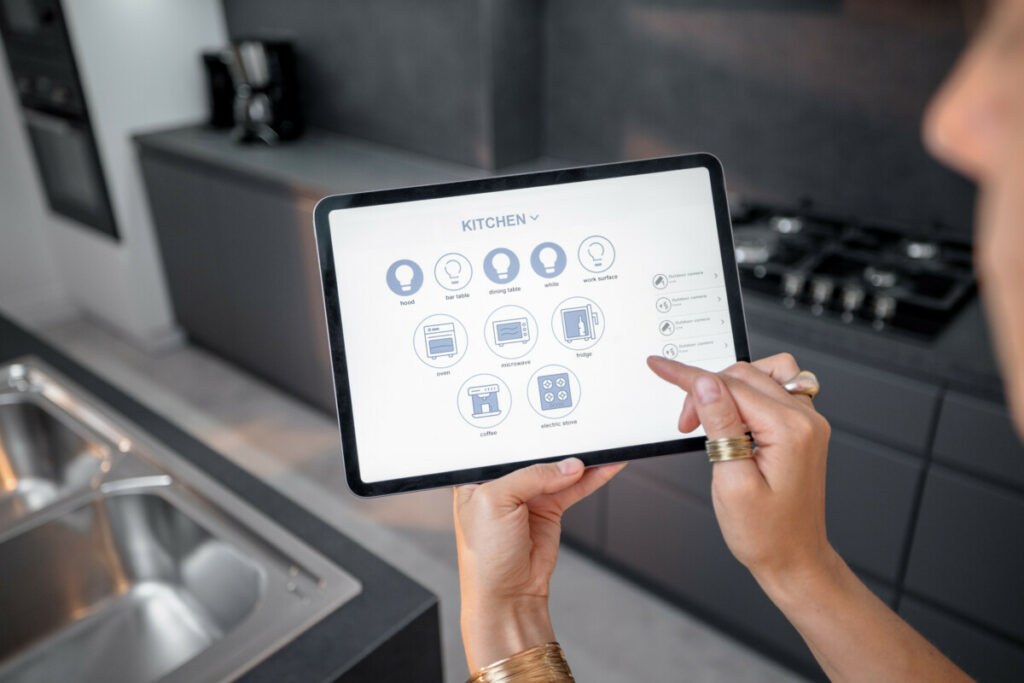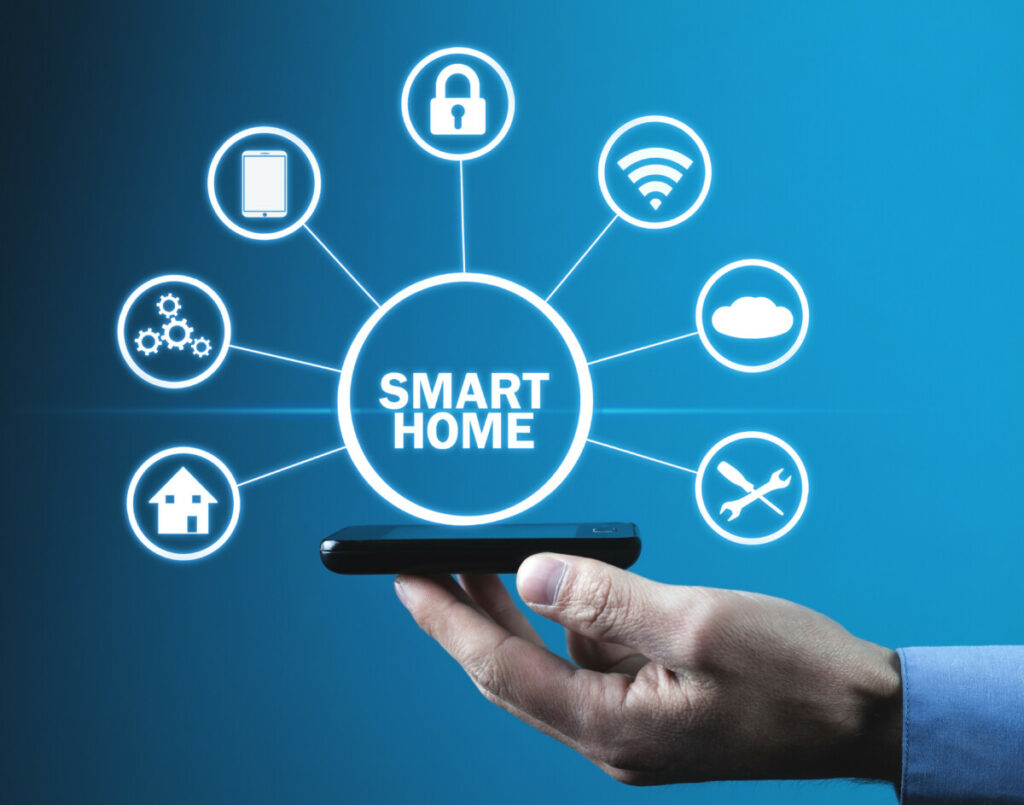- Making the Most of Your Smart Home: Common Use Cases - March 28, 2023
- Eco Mode at Night: Maximizing Nest’s Energy Savings - March 20, 2023
- Connecting & Controlling Smart Home Devices: A Guide - March 18, 2023
Disclosure: Links marked with * are Affiliate Links. As an Amazon Associate, I earn from qualifying purchases if you decide to make a purchase through these links – at no cost for you!

A smart home is a convenient home set-up that enables appliances and devices to be automatically controlled remotely. Devices are interconnected through the internet to allow users to control functions related to security access, temperature, lighting, and more features in the home.
Smart devices are used in the home to monitor indoor and outdoor controls through a variety of companies such as ADT, Ring, and Brinks security companies. These companies can provide indoor, outdoor, and feature controls on apps to enable users to control their smart homes efficiently.
There are several smart home devices, and each type has its own setup. Here is the ultimate guide to connecting and controlling smart homes.
Table of Contents
Smart Home Systems

There are several smart home systems that you can choose between. Smart home systems can either be purchased hardwired or wireless in the home. I have written about several options below.
Cove Home Security
Cove Home security is a new type of wireless system to start up for the Cove. They offer most of the similar services you can find from any veteran company.
Cove does not require customers to sign a contract or pay any activation fees. Its products are compatible with the Nest Thermostat and the August Smart Lock.
Setting up your Cove Home Security can be easy if you follow these steps.
First, install your equipment. Cove provides detailed instructions on how to install each piece of equipment. In general, installation involves placing sensors and cameras in the appropriate locations and connecting them to your Cove Hub.
Once you have installed your equipment, it’s important to test your system to ensure that everything is working properly. Cove provides a testing mode that allows you to check the functionality of each piece of equipment. You should test your system regularly to ensure that it is always functioning correctly.
Finally, download the Cove app to your smartphone or tablet. This app allows you to control your system from anywhere and receive alerts and notifications in real time. The app is available for both iOS and Android devices.
Ring
Ring products are highly rated, with most of them receiving 4.5 stars. from customer review platforms. Ring offers a unique approach to home monitoring and other security systems in the industry.
Ring is such an easy device to set up that even a child could do it. Here are simple instructions on how to do so for you to follow.
First, create a Ring account on Ring’s website. This account will allow you to manage your system, receive alerts and notifications, and access your video recordings. You can create an account by visiting the Ring website and clicking on the “Create Account” button.
Once you have created your Ring account, it’s time to install your equipment. Ring provides detailed instructions for installing each piece of equipment, so be sure to read these instructions carefully. In general, installation involves placing sensors and cameras in the appropriate locations and connecting them to your Ring Base Station.
Once you have installed your equipment, it’s important to test your system to ensure that everything is working properly. Ring provides a testing mode that allows you to check the functionality of each piece of equipment.
Ring offers professional monitoring services to provide you with an added layer of security. To set up monitoring, you will need to choose a monitoring plan and activate it through your Ring account. Ring offers a range of monitoring plans, so you can choose the one that best fits your needs.
Finally, you will need to download the Ring app to your smartphone or tablet. This app allows you to control your system from anywhere and receive alerts and notifications in real time. The app is available for both iOS and Android devices.
Google Home Mini
Google Home Mini is a smart speaker that can help you to control your smart home devices, play music, set reminders, and answer your questions. Setting up Google Home Mini is a straightforward process.
First, connect your Google Home Mini to a power source using the included power adapter. You will then download the Google Home app. The app is available for both Android and iOS devices.
Connect Google Home Mini to Wi-Fi Now, open the Google Home app on your smartphone or tablet, and follow the on-screen instructions to set up your Google Home Mini. You will be asked to connect your Google Home Mini to a Wi-Fi network. Once your Google Home Mini is connected to Wi-Fi, the app will prompt you to set up your Google Assistant. You will be asked to train the Google Assistant to recognize your voice by saying a few phrases.
After setting up your Google Assistant, you can customize your Google Home Mini to suit your preferences. You can change the name of your device, enable or disable different features, and link your Google Home Mini to other devices.
Alexa
Alexa is a voice-controlled virtual assistant developed by Amazon. It can be used to play music, set reminders, and control smart home devices. Setting up Alexa is a straightforward process if you follow the steps below.
First, download the Alexa app. The Alexa app is available for iOS, Android, and Fire OS devices. Download the app from the App Store or Google Play Store, or access it from the Amazon website. Then connect your Alexa device.
To connect your Alexa device, plug it into a power source and wait for it to turn on. Your device will show an orange light, indicating that it is in setup mode.
Next, open the Alexa app on your smartphone or tablet and sign in with your Amazon account. In the Alexa app, tap the Devices icon in the lower right corner, then tap the plus sign in the upper right corner. Choose the type of device you are setting up, such as Echo or Echo Dot, and follow the on-screen instructions to connect your device to your Wi-Fi network.
Once your Alexa device is connected, you can configure its settings such as the device name, language, and time zone. You can also set up multi-room music, voice profiles, and other features.
Alexa can be customized with additional features called “skills.” To enable a skill, open the Alexa app, tap Skills & Games, then browse or search for the skill you want to add. Tap Enable to add the skill to your Alexa device.
Things you can Control with your Smart Home

Smart home products allow greater control over heating devices. Control can be given over these appliances even when products have been turned on, off, and controlled. Smart products have sensors that detect any temperature or humidity changes in the air.
Audio/Visual aspects of smartphones are connected with each other equally and can even be controlled with a single remote. Televisions and other speakers have a greater capability to use command applications, maintain a schedule, and be voice controllable.
One of the most important aspects of smart house monitoring is the fact that smart home monitors have video and camera capabilities. These features can track any motion and provide video or live video feeds. These video capabilities can enable video-calling and audio capabilities.
How to Control Everything in Your Smart Home

These are all different kinds of apps that can control everything in your smart home. If you prefer voice automation commands to turn on or off lights and other appliances, you can pick a certain category that qualifies as your favorite kind of device.
Smart homes also have parental controls that can help parents create a safer and more secure environment for their children by limiting access to certain devices or features, setting time limits, and monitoring usage.
Many smart home hubs, such as Amazon Echo and Google Home, offer parental controls that allow you to limit access to certain features or devices.
For example, you can set up voice recognition to prevent your child from making purchases or using certain skills. You can also set up a PIN code to control access to certain features or to keep your child from turning off parental controls.
Some smart speakers offer parental controls that allow you to block explicit content and restrict access to certain services. For example, you can set up parental controls on Amazon Music to prevent your child from listening to explicit songs.
Many smart TVs offer parental controls that allow you to restrict access to certain content based on ratings, block specific shows or channels, and set time limits.
Some systems offer parental controls that allow you to limit access to certain features or devices. For example, you can set up a notification system to alert you when your child arrives home or leaves the house.
Another great way to control your smart home is through smart home routines. A smart home routine is a series of actions that are triggered by a single command or event.
For example, you can set up a routine to turn off all of your lights, lock your doors, and set your thermostat to a specific temperature with just one voice command. Smart home routines can be customized to fit your specific needs and preferences, making your home more comfortable and efficient.
When it comes to controlling your smart home automation system, there are several options available, including built-in hubs, moveable hubs, apps on phones or tablets, and smartwatches.
Built-in Hubs
Built-in hubs are installed directly into your home and are typically part of a larger smart home automation system. These hubs can be controlled through a dedicated app or voice assistants, such as Amazon Alexa or Google Assistant.
Built-in hubs are often more powerful than moveable hubs or apps, as they can support a wider range of devices and offer more advanced features.
Moveable Hubs
Moveable hubs, such as the Google Nest Hub or Amazon Echo Show, are standalone devices that can be moved from room to room as needed.
These devices often have built-in voice assistants and touch screens, which allow you to control your smart home devices with your voice or by using the touch screen.
Moveable hubs are often less powerful than built-in hubs, but they offer more flexibility and can be a good choice if you want to control your smart home devices from different rooms or locations.
Apps on Phones or Tablets
Many smart home automation systems come with dedicated apps that can be downloaded to your phone or tablet. These apps allow you to control your smart home devices from anywhere, as long as you have an internet connection.
Using apps on your phone or tablet can be a convenient way to control your smart home devices, as you always have your phone or tablet with you.
However, these apps can be less powerful than built-in hubs or moveable hubs, and they may not support all of the features of your smart home automation system.
Smartwatches
Smartwatches, such as the Apple Watch or Samsung Galaxy Watch, can also be used to control your smart home devices. Many smart home automation systems offer apps that can be downloaded to your smartwatch, allowing you to control your devices with your voice or by using the touch screen on your watch.
Using a smartwatch to control your smart home devices can be a convenient way to quickly turn on or off lights, adjust your thermostat, or lock your doors.
However, smartwatches may be less powerful than other control options and may not support all of the features of your smart home automation system.
Types

Voice Control
Voice control is a convenient way to give commands without having to press a button. With this kind of system, you can turn on the lights, change the settings on the air conditioning, and even boil water with your voice.
A nice way to do this is through a smart speaker. Smart speakers are handy devices that pick up the sound of your voice to do a number of commands relating to setting the alarm, playing music, and turning the lights in the home on and off.
Most speakers will allow you to control the lights in the home, play music, ask questions, set reminders, and many other commands depending on the limits of the speaker device.
Voice control is one of the most popular ways to control smart home devices, and Google Home and Amazon Alexa are two of the most popular voice assistants available. Here’s a step-by-step guide on how to use voice controls through Google Home or Alexa:
To use Google Home, simply use your voice to control your smart home devices. Say, “Hey Google” or “OK Google” followed by the command you want to give. For example, you could say “Hey Google, turn on the living room lights,” or “OK Google, set the thermostat to 70 degrees.”
To use Amazon Alexa, you merely need to say, “Alexa” followed by the command you want to give. For example, you could say “Alexa, turn off the bedroom lights,” or “Alexa, lock the front door.”
When using voice control, make sure to use specific commands when controlling your smart home devices. For example, say “turn on the living room lights” instead of “turn on the lights.” Speak clearly and use a natural tone of voice when giving commands. This will help your voice assistant understand you better.
Both Google Home and Alexa allow you to set up routines. They can be activated through voice control. For example, you could set up a “bedtime” routine that turns off all the lights and sets the thermostat to a comfortable temperature.
Smart Plugs
Smart plugs can easily transform appliances such as lamps, fans, and more into smart devices that can be controlled through your mobile device. To do this, simply plug this device into a wall outlet, download the app, and connect your non-smart device.
Certain kinds of smart plugs can control voice commands, predict how much power your device will have, and how to best preserve your power over time.
Smart Light Bulbs
Smart light bulbs let you control an individual light as well as a group of lights. You can control the temperature, color, and brightness level of your lights to make your home the most ideal setting for every event. If you want to dine, read a book, watch a movie, or host a party, you can control the lighting through your phone.
If you don’t want to control light bulbs, you can use a smart wall switch instead. This option enables users to control the existing light fixtures you have in their homes. The installation process for this device uses high-voltage electrical wiring.
Smart Thermostat
Smart thermostats let you control your air conditioning through your phone. For example, if you left on a trip and forgot to turn off your air conditioning to save money, there is no need to fear. You can simply turn on or off the air conditioning in your home through your phone.
You can automatically adjust the temperature based on what time of day, location, and status of other connected devices. Some models control the heating and cooling of your home by using remote room sensors.
Home Security
Smart locks let you lock or unlock the door of your house on your phone. Some may even let you manage permanent or time-specific access to let trusted family members, friends, or coworkers come into your home.
Most smart locks come in complete sets and are simple to install. Smart doorbells let you see and speak to people on your front porch when they come to your house. This can help you to know who has stopped by while you’re away from home.
This feature can help you to get out of impending danger to your home before it happens, view feeds on your phone from smart displays, and pair with cameras to create a whole system of devices with sensors to detect motion. These sensors can send you alerts and save any recordings.
Indoor and outdoor security cameras make it possible to monitor any activity going on outside and inside your home. Some indoor cameras will use motorized components that offer a 360-degree view of a room.
Outdoor cameras are made to withstand the elements such as rain, snow, or heat. Some even have floodlights installed to light up driveways and backyards.
Attention: When installing electronic equipment, please be sure to observe the manufacturer’s safety instructions. You have to take care of your own safety. The information on this site only helps you to learn.
Disclosure: This website is the property of Martin Lütkemeyer and is operated by Martin Lütkemeyer. Martin Lütkemeyer is a member of the Amazon Services LLC Affiliate Program, an affiliate advertising program designed to enable Web sites to earn advertising revenue through advertising and linking to Amazon.com. Links marked with * are affiliate links.
